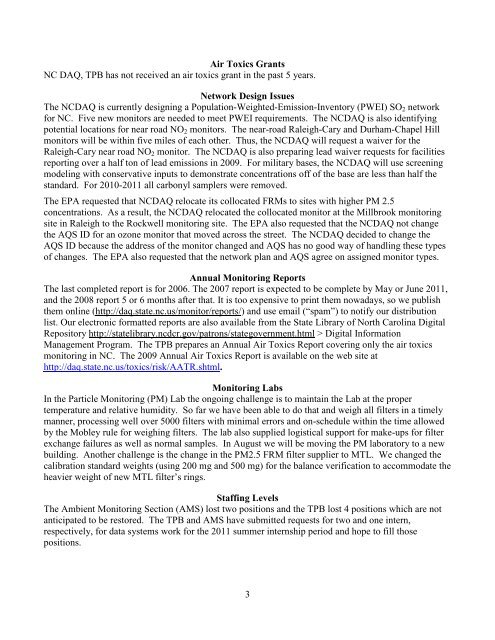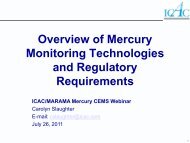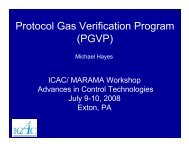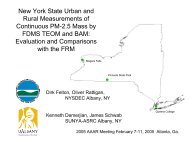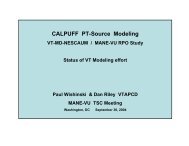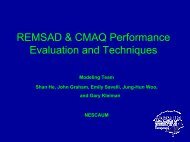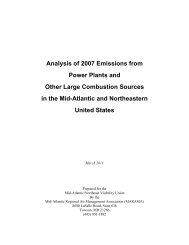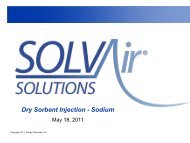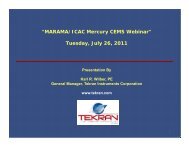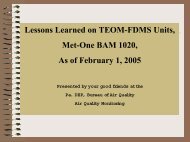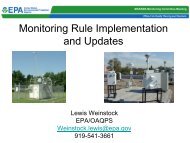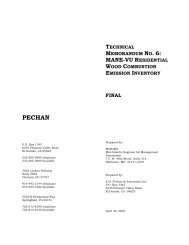North Carolina - MARAMA | Mid-Atlantic Regional Air Management ...
North Carolina - MARAMA | Mid-Atlantic Regional Air Management ...
North Carolina - MARAMA | Mid-Atlantic Regional Air Management ...
- No tags were found...
You also want an ePaper? Increase the reach of your titles
YUMPU automatically turns print PDFs into web optimized ePapers that Google loves.
<strong>Air</strong> Toxics GrantsNC DAQ, TPB has not received an air toxics grant in the past 5 years.Network Design IssuesThe NCDAQ is currently designing a Population-Weighted-Emission-Inventory (PWEI) SO 2 networkfor NC. Five new monitors are needed to meet PWEI requirements. The NCDAQ is also identifyingpotential locations for near road NO 2 monitors. The near-road Raleigh-Cary and Durham-Chapel Hillmonitors will be within five miles of each other. Thus, the NCDAQ will request a waiver for theRaleigh-Cary near road NO 2 monitor. The NCDAQ is also preparing lead waiver requests for facilitiesreporting over a half ton of lead emissions in 2009. For military bases, the NCDAQ will use screeningmodeling with conservative inputs to demonstrate concentrations off of the base are less than half thestandard. For 2010-2011 all carbonyl samplers were removed.The EPA requested that NCDAQ relocate its collocated FRMs to sites with higher PM 2.5concentrations. As a result, the NCDAQ relocated the collocated monitor at the Millbrook monitoringsite in Raleigh to the Rockwell monitoring site. The EPA also requested that the NCDAQ not changethe AQS ID for an ozone monitor that moved across the street. The NCDAQ decided to change theAQS ID because the address of the monitor changed and AQS has no good way of handling these typesof changes. The EPA also requested that the network plan and AQS agree on assigned monitor types.Annual Monitoring ReportsThe last completed report is for 2006. The 2007 report is expected to be complete by May or June 2011,and the 2008 report 5 or 6 months after that. It is too expensive to print them nowadays, so we publishthem online (http://daq.state.nc.us/monitor/reports/) and use email (“spam”) to notify our distributionlist. Our electronic formatted reports are also available from the State Library of <strong>North</strong> <strong>Carolina</strong> DigitalRepository http://statelibrary.ncdcr.gov/patrons/stategovernment.html > Digital Information<strong>Management</strong> Program. The TPB prepares an Annual <strong>Air</strong> Toxics Report covering only the air toxicsmonitoring in NC. The 2009 Annual <strong>Air</strong> Toxics Report is available on the web site athttp://daq.state.nc.us/toxics/risk/AATR.shtml.Monitoring LabsIn the Particle Monitoring (PM) Lab the ongoing challenge is to maintain the Lab at the propertemperature and relative humidity. So far we have been able to do that and weigh all filters in a timelymanner, processing well over 5000 filters with minimal errors and on-schedule within the time allowedby the Mobley rule for weighing filters. The lab also supplied logistical support for make-ups for filterexchange failures as well as normal samples. In August we will be moving the PM laboratory to a newbuilding. Another challenge is the change in the PM2.5 FRM filter supplier to MTL. We changed thecalibration standard weights (using 200 mg and 500 mg) for the balance verification to accommodate theheavier weight of new MTL filter’s rings.Staffing LevelsThe Ambient Monitoring Section (AMS) lost two positions and the TPB lost 4 positions which are notanticipated to be restored. The TPB and AMS have submitted requests for two and one intern,respectively, for data systems work for the 2011 summer internship period and hope to fill thosepositions.3


